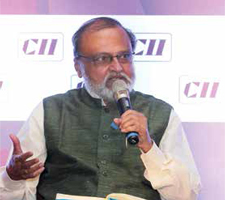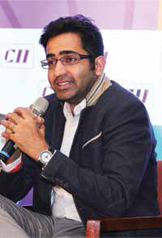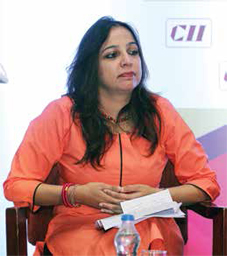In a country like India with a population of 1.3 billion, it becomes difficult for the government to meet the needs of its citizens all by itself. This is where Public Private Partnerships (PPPs) come in. PPPs are unique partnerships between the government and the private sector which help in building infrastructure, skilling workforce and bringing a better quality of life to Indian citizens, especially those from rural backgrounds. With a view of understanding PPPs’ role in meeting the sustainable development goals of India, the Confederation of Indian Industry (CII) had organised a CSR Summit in Pune. Corporate Citizen brings you the riveting discussion
 L to R - Sachin Joshi, Rajendra Shende, Anurupa Patni Jain, Umakant Dangat, Rajendra Ghume, & Soumya Jain
L to R - Sachin Joshi, Rajendra Shende, Anurupa Patni Jain, Umakant Dangat, Rajendra Ghume, & Soumya JainIndia is home to 1.3 billion people. Employment is one of the primary concerns for the youth of this nation. In fact, India has one of the largest demographic dividends in the developing countries. Due to the public sector limitations, not all the job-seekers can be employed by the government. As a result, job -seekers turn to the private sector for employment. This is where the gap start to appear. There is a huge difference between the output of the education sector and the requirements of the industry. Job-seekers need to be trained in a variety of ways before they are job-ready. This is one of the many areas where PPPs can play a huge role. By joining hands with the industry, the government has been able to upskill thousands of young job-seekers who are then accommodated in the private sector. This in turn helps meet the sustainable development goals of the nation.
The importance of PPPs in creating employment is significant, but PPPs can help in schooling young children and making them self-reliant from a very young age. Municipal corporations across the country can partner with private players to upgrade the educational output of government- run schools in order to deliver a better future for the children. In fact, the younger the children, the easier it is to shape them.
PPPs can also transform rural areas from being completely reliant on the government to becoming self-sufficient. From education, healthcare, employability to industry, rural areas have shown tremendous progress with the help of PPPs.
As described above, the role of PPPs in the development of India cannot be understated. The success of a PPP depends on several factors. The best way to get a clearer idea about this is from people who are deeply involved in the whole process. Sachin Joshi, Chief operating Officer at CII-ITC Center for Sustainable Development, chairs a session with Rajendra Shende, Chairman, TERRE Policy Centre, Umakant Dangat,Jt Secy at Govt of Maharashtra, Soumya Jain, Co-Founder, iTeach, and Anurupa Patni Jain, Business Leader, Corporate Partnerships, The Akshaya Patra Foundation, to understand how India can meet and excel at our sustainable development goals by leveraging PPPs.

Rajendra Shende: In my experience, you can see massive success on a global level but still fail on the local level. I believe the partnerships on the local level are more instrumental in execution than those on the global level. I believe that our Prime Minister Narendra Modi has said that our country doesn’t have 125 cr people, it has 125 cr opinions. Getting these opinions together and formulating a cohesive scheme is the real challenge. What is a ray of hope for us are young minds, who are in schools and universities, who are ultimately going to turn the challenges we face today into success. It is very important that we start working with them and addressing their concerns. When I went to the UN years ago, instead of holding conferences in 5-star hotels, we went to students and interacted with them. We identified the sustainable development goals and tried to achieve them together
"I believe that our Prime Minister Narendra Modi has said that our country doesn’t have 125 cr peopl e, it has 125 cr opinions"
- Rajendra Shende

Soumya Jain: Thank you for giving me the opportunity to share what we learnt about SDGs and PPPs, and the development sector as a whole. I am an engineer by training and I did my master's in the US where I also worked for six years. five years ago, I moved to India to work in the education space, especially for the education of lower-income students. I head an organisation called iTeach. We founded it about three years ago in partnership with the Pune Municipal Corporation (PMC) and our CSR partners. iTeach runs five free secondary schools all across Pune. Out of the 330 PMC schools, also known as government schools, only 20 go all the way to Std 10. The highest grade of education offered is grade 7 or grade 8. Post this, students are forced to try and find private schools if they want to complete their education. This, in most cases, is not affordable to their families, and even private schools do not really want municipal school students to join them. This cycle is vicious. To try and break this, we started schools which offered grades from Std 8 Std 10 and we only enrolled students who have passed out of government schools and helped them get a good-quality education. We are adding two more schools next year as well. We will have seven schools with close to 1,500 students by 2019. We have had a good experience with PPP. The PMC provides us with the infrastructure, in the form of classrooms, and our CSR partners fund us which enables us to hire the best-quality teachers and principals and other associated staff. The PPP model has worked really well for us in the past three years. Everything has come together fabulously to help students achieve their dreams. We had 109 students who gave their SSC board exams last year, and all of them cleared. 105 of them are enrolled in leading junior colleges in the city.
I feel there is tremendous potential in this model.
"We had 109 students who gave their SSC board exams last year, and all of them cleared. 105 of them are enrolled in leading junior coll eges in the city"
-Soumya Jain
Rajendra Ghume: Skill development is a very important aspect in the current job scenario. The government has a large role in developing skillsets, but unfortunately in the past few decades, the output has been a little lacking. From 2005-06, we entered into PPP with the industry, and they are now in the driver’s seat vis-à-vis skill development. As far as Maharashtra is concerned, we have PPP in almost 256 industrial training institutes (ITIs) out of 420. So more than 50% ITIs are run by the industry. The Govt. of India has given 2.5 crore to develop these institutes, upgrade their skills, bridge the gap between skill and industry and supply skilled manpower to the industry. When we see vocational training in the US and Europe, it has become the responsibility of the industry and industrial associations. Now, even India is walking down that path. I must mention Bharat Forge, which has become a historic PPP in India. Bharat Forge has contributed more than 8 crore to set up ITIs, set up the infrastructure and they have taken complete initiative for everything. Employability is a process, which must be achieved with all stakeholders. The govt. and industry are taking a keen interest in improving employability of students. There has been tremendous development in the setting up and upgradation of ITIs in recent times. Courses which used take one to two years are now being streamlined to three to four months. The government is making it very easy for the industry by making every process industry- friendly and removing the red tape involved in the industry’s participation of ITI. We are encouraging more and more industries to come forward and participate in the setting up and development of ITIs, which will benefit both industries as well as the workforce.

Dr Umakant Dangat: I have been working with the state govt. for 35 years, and have retired in 2016. The Maharashtra state govt. under Chief Minister Devendra Fadnavis has undertaken a very ambitious programme, the Maharashtra Village Social Transformation Foundation. This is a unique initiative.
After independence, India has developed at a very rapid pace. Due to urbanisation and industrialisation, many new challenges are coming up. At the time of Independence, over 80% of the population lived in villages. Today, in Maharashtra at least, 50% of the population lives in villages and the other 50% in cities. Because of this migration, sustainability is a challenge. When you talk about SDG's, villages need more attention. In Maharashtra, out of the 50% people living in villages who primarily work in the agricultural sector, their share in the state GDP is only 12%. Around 30% people are working in the industrial sector. Their share in the state GDP is around 30%. 15% of the population works in the service sector, but its share in the state GDP is around 58-60%. Becasue in this stark difference in incomes, there are issues. Our state is facing an agrarian crisis. The growth rate was -0.3%. The service sector growth on the other hand increased by 9%. The biggest challenge before the state is the agricultural sector. This is why we need PPP. Many big corporates like Tata Trusts and Mahindra & Mahindra have contributed towards the initiative to transform villages. We are not only developing rural infrastructure, our emphasis is on social transformation. In the first phase, we have taken 1,000 villages for this transformation. Starting from sanitation, schools, healthcare, etc. everything is being developed. We are also focused on the financial development of the villages through agricultural and skill development. Our corporate partners are not only our CSR partners, but they help instill a corporate culture into the transformation, which focuses on efficiency and quality. After the first phase of 1,000 villages, we are looking to take this model all over the state so that every village becomes a model and vibrant village, where all the five pillars of sustainability, i.e., economy, social, environmental, safety and security and cultural vibrancy are all present.
"At the time of Independence, over 80% of the population lived in villages. Today, in Maharashtra at least, 50% of the population lives in villages and the other 50% in cities"
-Dr Umakant Dangat

Anurupa Patni Jain: I am very glad to be a part of this foundation, which works for the basic requirements of society. In our society, when even the basics are lacking, it is difficult to provide value-added services to the needy. Our focus has been sustainability and scaling our operations. We are currently present pan-India in 12 states and we will be expanding to more states this year onwards. We have been able to do this as one of the world’s most successful PPPs. We are now the world’s largest mid-day meal provider. Our primary focus is the most basic, food, which is unfortunately not available to the 39% of our population, who are children. The hot and nutritious meals we provide is something which is valuable to most of the poor children as many times they do not get even one proper meal during the day. We have already seen that this mid-day meal is an incentive to parents to send their children to school. And once they come to schools, we can educate them and give them opportunities to succeed in life. So as you can see, it all boils down to food. We are currently feeding around 1.7 million children across the country. Our kitchens are featured on the mega kitchens programme. Most of our centralised kitchens have a capacity to feed more than a lakh of children each day. Our smaller kitchens, like in Nagpur and Thane, can feed around 5,000 a day. Our kitchens are ISI-certified, with automated processes in most of our kitchens. The idea is to be sustainable. We have a committed team of 5,000 employees. We create a small ecosystem at every area we work. We aim to reach zero-hunger one-day. 42% of the world’s malnourishment is in India. Until we focus on fixing this appalling statistic first, we can’t go beyond. The challenges we see in rural and urban areas are obviously different. In rural areas, money is an issue. In urban areas, obesity and junk food is an issue. We have to deal with each challenge differently.
"Our primary focus is the most basic, food, which is unfortunately not available to the 39% of our population, who are children"
-Anurupa Patni Jain
India is the 67th out of 85 countries on the Global Hunger Index. Therefore, we need a plan if we want to end hunger. We have to deal with hunger, malnourishment and related issues if we have to meet the SDGs of the nation.
By Neeraj varty